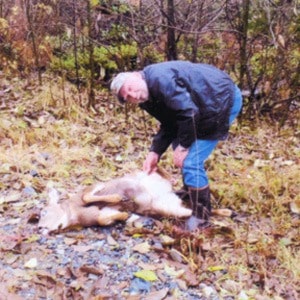Hunting is one of the oldest skills of man and possibly one of the important factors in our rise from simple gathering cultures to the complex civilization of the 21st century. Hunting frequently supplied surpluses of food, clothing and shelter which may have led to planning time in hunting- gathering cultures developing agriculture and ultimately large cities.
All of this is conjecture on my part; but it is indisputable that hunting is one of the oldest skills of modern man. We are currently encouraging back-to-nature movements and growth of local food through home gardening, local agricultural support programs, raise your own chickens, goats and so forth.
Hunting is rarely mentioned in these back-to-the-land programs, but recreational hunting is an important method of harvesting locally produced organic meat. We hear much these days about the increasing conflicts between urban communities and agricultural activities that are impacted by Canada geese, rabbits, bears, crows and deer populations, to name a few creatures that are adapting to urban life and thereby posing serious problems for gardening, local agriculture, traffic and personal safety.
In the book Wildlife Conservation Policy edited by Valerius Geist and the late Ian McTaggart-Cowan, the following points were noted in an essay Man, Wildlife and Conservation in North America by McTaggart-Cowan: "Habitat change by man has been part of North American history since long before the arrival of Europeans. The consequences of these alterations to the natural environment cannot be measured, but are seen to be very great. Many species have proven highly resilient and able to adapt to greatly altered habitats; one need only mention the raccoon, coyote, grey squirrel, white-tailed deer, Columbian black-tailed deer, cottontail rabbit, mallard duck, Canada goose, and American crow, as examples."
My rationale in raising these examples is to point out that responsible hunting still adds much to the production of local food where harvesting these animals is done in a legal, safe and sensitive manner.
Smitty and I grew up in a generation that supported hunting for family meat and as an important recreational pastime. Last week we took a reconnoitering trip to look at some elk range in preparation for an upcoming Limited Entry Elk hunt. It was natural that we took our rifles because there is always the chance we would run into an Island black tail buck.
Pictured with this column is one such buck that Smitty is cleaning before we loaded it into the truck. The deer in question weighed about 70 pounds and will be processed as quality meat and sausage. It is a locally grown, organic product of Vancouver Island.
From the 2010-2012 Hunting and Trapping Regulations Synopsis outlined below is a rough overview of the legal hunting seasons for black tailed deer and Canada geese for Region 1, Vancouver Island. These two species are frequently in the forefront of conflict interaction between urbanization and agricultural enterprises.
Black-tailed deer – Firearms season (shotgun and rifle) runs from Sept. 10 to Dec. 10. Bag limit is two deer. Archery season from Aug. 25 to Dec. l0. See regulations for special areas to hunt and local management area regulations.
Canada geese – The seasons for these birds is broken over several months extending from Oct. 8 to March 10, 2012. This is to allow ample harvest as can reasonably be taken to reduce the excessive numbers of this highly adaptive bird.
Recently in Island press sources we have seen cases of deer that were wounded by arrows and either died on somebody's lawn or continue to suffer from the effects of an arrow somewhere in their body. There is no defence for this irresponsible practice by poachers masquerading as bow hunters. Archery is an ancient skill and is an effective hunting tool in the hands of a competent archer. In the hands of a scheming
poacher it is being misused, primarily because of the silence associated with archery.
Our hunting regulations are based on solid principles of sustainability, conservation, fair chase and human safety. McTaggart-Cowan was an icon of international conservation practices and nature study and his ground-breaking research and practices set the standards for British Columbia's wildlife management programs that regulate our current hunting practices.
Hunting can be an important bridge in the back-to-nature movement.
Ralph Shaw is a master fly fisherman who was awarded the Order of Canada in 1984 for his conservation efforts. In 20 years of writing a column in the Comox Valley Record it has won several awards.
